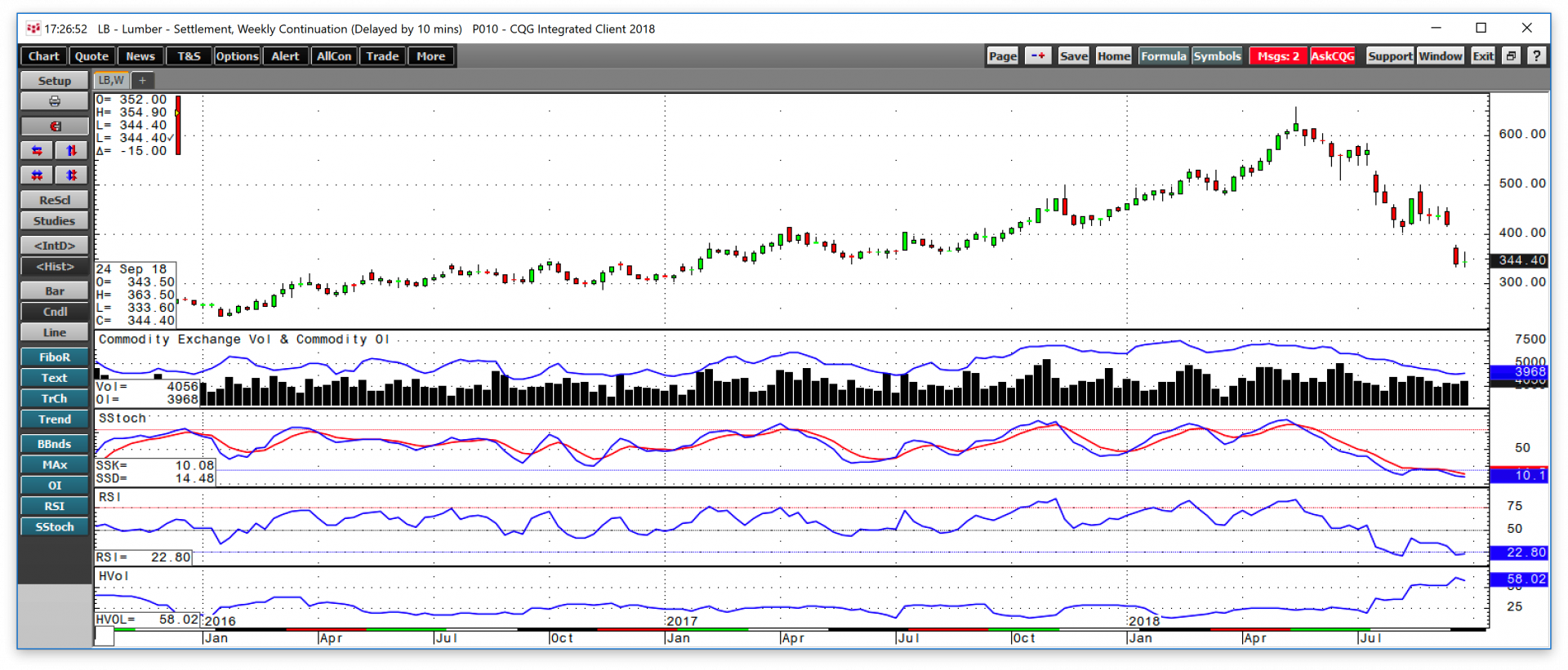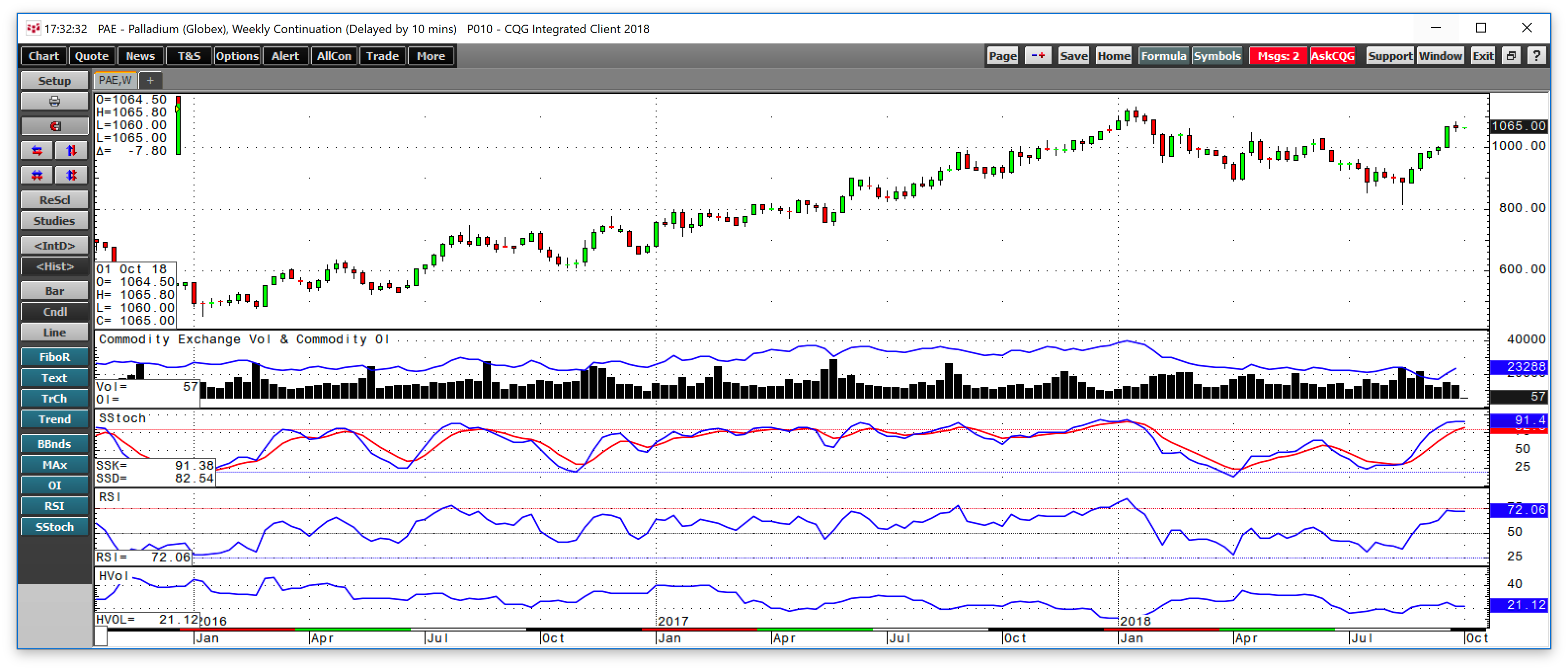The dollar index moved higher by 0.41% in the third quarter of 2018, and commodities prices moved lower, with all six major sectors posting losses. The composite of 29 raw material markets that trade in the U.S. and U.K. gained 7.95% in 2017. In Q3, commodities lost 4.81% and are down 3.90% over the first nine months of 2018.
Soft commodities were the worst performing sector with base metals a close second
During the period from July 1 through September 28, 2018, the soft commodities sector was the big loser in the commodities asset class, posting an 11.51% loss. Cocoa, sugar, and cotton posted double-digit percentage losses.
The second worst performing sector was base metals which fell by 10.39% for the three-month period. LME lead, nickel, and zinc were down by double-digits on a percentage basis since the end of Q2 as of September 28.
The worst performing commodity was another industrial raw material, lumber. The price of the illiquid lumber futures contract fell 39.5% in Q3.
As the weekly chart shows, lumber futures fell from a new all-time high at $659 in May 2018 to settle Q3 at $344.40 per 1,000 board feet, a decline of 47.7% from the high. Trade issues with China and Canada and higher U.S. interest rates drove the price of wood lower during the third quarter. Open interest declined from 6113 at the end of Q2 to 3,968 at the end of Q3 in the thin market, a drop of 35%. Weekly historical volatility moved from 23.42% to 58.03% over the period.
Other notable declines in the commodities markets came in lean hog futures which were 24.98% lower over the period. The commodities that fell by 15-20% included LME lead with declined by 17.25%, cocoa with a 16.92% loss, LME nickel that dropped 15.99%, and rise which fell by 15.76%. Raw materials that shed between 10-15% of their value were sugar with a 14.94% loss, LME zinc that declined 12.82%, and cotton with a loss of 10.10%.
Those commodities that lost 5% to 10% were silver which declined 8.64%, soybean meal which moved 8.23% to the downside, coffee futures that fell 8.12%, and FCOF which lost 7.49%. LME copper suffered a 7.01% loss. LME aluminum fell 5.84%, and gold was down 5.02% in Q3. Smaller losses of 0-5% were seen in COMEX copper which lost 4.95%; platinum dropped 3.95%, LME tin posted a 3.45% loss, while gasoline fell 3.04%. Soybeans and soybean oil both fell 1.51% and NYMEX crude oil bucked the trend in the energy sector with a 1.21% decline in Q3.
Palladium appreciates in Q3, but few other winners
The big winner in Q3 was palladium futures, which climbed 12.82% over the three-month period that ended last Friday.
As the weekly chart highlights, NYMEX palladium futures fell to a new low for the year at $815.20 in mid-August when other precious metals fell on a new high in the dollar index futures contract at 96.865. However, palladium turned higher and was climbing towards the all-time high at $1133 per ounce which was the January 2018 high at the end of the third quarter of this year. Palladium was the only double-digit percentage winner in Q3.
Commodities that moved between 5% and 10% to the upside include MGE wheat which appreciated by 9.78%, KCBT wheat with an 8.60% gain, and heating oil which was 6.28% higher. Live cattle futures moved 6.03% to the upside, iron ore was up 6.18%, and oats rallied by 5.69%. The commodities that were 3% to 5% higher were feeder cattle which moved 4.53% above the Q2 close, and Brent crude oil which posted a 4.35% gain.
Marginal increases of 1-3% occurred in natural gas which was up 2.87%, CBOT with a 2.31% gain, and corn which rebounded by 1.71%.
Q3 Highlights – Trade issues and rising rates weigh on raw material prices
The Fed hiked rates by 25 basis points at their September meeting, telling markets to expect at least one more increase before the end of this year, which will bring the Fed Funds rate to 2.25-2.50% by the end of 2018. The Fed has continued their program of quantitative tightening as the legacy of QE rolls off the central bank’s balance sheet, which is putting upward pressure on interest rates in the medium and long end of the yield curve in the United States. Economic data continues to favor higher yields on government debt securities.
China is the world’s leading commodities consumer as 1.4 billion people in the nation with the world’s most populous and second largest economy has been the demand side of the fundamental equation for raw materials for decades. In 2018, the wave of protectionist policies by the Trump Administration has changed the supply and demand fundamentals, and herd behavior in many commodities markets as tariffs and retaliatory measures tend to distort the fundamental supply and demand balance in many commodities markets.
The trade friction between the U.S. and China began in Q2 escalated over the course of Q3. The first round of $50 billion in U.S. tariffs on Chinese goods flowing into the United States went into effect in Q3. At the end of the quarter that ended on September 28, the U.S. upped the ante on trade as President Trump rolled out a 10% tariff on another $200 billion in Chinese exports to the U.S. with the rate going up to 25% if there is no progress on trade by the end of 2018. Moreover, President Trump warned the Chinese that he has tariffs on another $257 billion in his back pocket ready to go if the Chinese decide to retaliate against the latest move by the U.S., which is an attempt to force China to the negotiating table. The escalation in the protectionist wave where the U.S. is trying to level the playing field on trade and China is struggling to maintain the status quo could lead to both a trade and currency war. Jack Ma, the founder of Alibaba, warned that a trade war could last for decades in September. China said that they would slap tariffs on U.S. LNG exports and an additional $60 billion in U.S. exports. While the U.S. imports a lot more goods from China than the Chinese import from the U.S., President Trump has the upper hand when it comes to the level of tariffs. However, China’s continued devaluation of their currency and the nation's expensive holding of U.S. Government debt securities could become potent weapons for China in the weeks and months ahead if the two sides continue to escalate. China also dominates the world’s supply of rare earth metals which are essential commodities for the production of strategic weapons, electronics, and many other products required by U.S. manufacturers.
Trade will likely dominate the news cycle in the world of commodities in Q4.
Prospects for Q4 – More volatility ahead
As we head into the final quarter of 2018, commodities will look forward to the injection season in natural gas. Inventories are heading into the peak season of demand at the lowest levels in years. At the same time, the 2018 crop year gets underway in the southern hemisphere.
Meanwhile, the U.S. central bank will continue its gradual path towards tightening credit. Economic data supports another 25-basis point rate hike at the final meeting of the FOMC in December.
Mid-term elections in the U.S. could exacerbate political divisions in November. A win by the Democrats would threaten the administration’s agenda. In November, new sanctions on Iran will take effect which could cause lots of price variance in the crude oil market. All of these issues and more, are a prescription for increasing price variance in markets across all asset classes.
Commodities tend to be the most volatile asset class of all, and the current economic and geopolitical landscapes point to a continuation of price volatility. Volatility is the mother’s mild of opportunities for nimble traders with their fingers on the pulse of markets.
All the best for Q4!

